Jurors’ Comments
審査講評
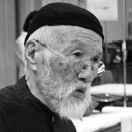
Nagatoshi Ohnishi (Japan)
- Urushi Artist, Professor Emeritus at Tokyo National University of Fine Arts and Music
Japanese people have received great benefits from living on a land where lacquer trees grow. Lacquer trees provided innumerable resources, from lacquer sap to edible shoots, berries for food and fodder, wax, dye, medicine, antiseptics and more. The use of lacquer trees dates back to the end of the Paleolithic era some 10,000 years ago. It is extremely important for Japanese people to recognize the historic tradition of the lacquer tree for the creation of Urushi art. We have consistently enjoyed the benefits of lacquer and nurtured Urushi culture for a long time.
The Ishikawa International Urushi Exhibition started in 1989 as the first international Urushi exhibition in the world, with the aim of developing this craft. The exhibition has remarkably stimulated the field of Urushi, not only in Japan, but also in other East Asian countries with traditional Urushi culture.
It is wonderful to see applicants with different traditions and values come together at the exhibition to compete through artistic expression in lacquer ware and deepen mutual understanding. Encouraged by this conviction, the exhibition has been held every three years, and this year we hold the eleventh exhibition. In addition to entries from France, Spain, Denmark, and Germany, this time we were able to see works by four artists from Russia, and one from the British Isle of Man. Russian lacquer tradition dates back to the Imperial era and has a high level of technical skill, so it is interesting to feel another sense of lacquer outside East Asia.
What I have learned from the exhibition is this; although we are in an age of globalization, the world is still wide with many places of hidden human wisdom. This international exhibition should show what you want to know, what we want you to know, and give new methods of research.Thus, the circle of the exhibition will be spreading.
The exhibition competition has two categories. In the Design Category, the usefulness of the objects should make our everyday life richer, better and fuller. Productivity, efficiency and practicality are also naturally required. At the same time, artistic quality, fashion and spirituality are involved. The Art Category also has its own conditions - high technical standard, expression with deep spirituality and the answer of the fundamental question, ‘What is Urushi?’.
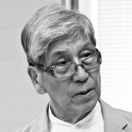
Motomi Kawakami (Japan)
- Chairman of the Japan Institute of Design Promotion (JDP),
- Representative of Kawakami Design Room Ltd.
The future of Urushi in the 21st century should look towards environmental stability, as well as the continuation of the Asian view of harmony with nature. Urushi hardens by absorbing moisture, and so it can provide the perfect utensils for use in the humid climate of Japan. This competition helps Urushi to transcend the individual traditions and cultural memories of lacquer ware in every Asian country, and look ahead internationally.
Urushi was formerly developed and refined under the patronage of powerful rulers. The techniques were handed down through generations of craftsmen, and masterpieces of lacquer ware were kept by many generations in one family. Many high-quality examples of Urushi can be seen in Buddhist temples. However, Urushi also plays a part in our everyday life, providing us with familiar utensils that are both simple and beautiful.
I’m honored to have been invited to judge in the Final Assessment this year. I have been able to appreciate anew the present state of Urushi art as it has widened and deepened conceptually with the passing of time.
Of course, in the works from Ishikawa I could clearly see the local flavor from the Kanazawa area, but at the same time, it was amazing to see some works at the Final Assessment venue that showed artists’ exploration of different genres. My only wish would have been to see more enthusiastic works from Japan together in one venue.
In countries outside Asia, there are traditions and techniques of varnishing, but not of true lacquer from the lacquer tree which grew only in Asia. When Orientalism was fashionable in Europe, Urushi was highly esteemed by the upper classes, and with Art Deco at the beginning of the 20th century, the work of a Japanese Urushi artist so captivated Eileen Gray that he moved from Paris to London with her.
Whenever I hear such historical facts, it captures my imagination and makes me wonder how many people in the world have been involved with Urushi. This year’s winning entries are from Russia and Germany. Although the work from Russia is varnished not with true lacquer, the delicate expression is impressive. I hope that new dimensions of Urushi art will be explored from various international perspectives.
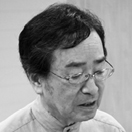
Shinichi Yamamura (Japan)
- Design Consultant,
- President of Cobo Design Co., Ltd.
Out of the 176 works submitted from 11 nations and regions, 22 works from abroad and 58 works from Japan were selected at the Preliminary Assessment. Through active discussion, the Grand Prize winner (joint decision of the Art and Design categories), the Gold Prize winners (one each for Art and Design), the Silver Prize winners (one each for Art and Design), the Honorable Mention winners (two each for Art and Design), and the Jurors’ Special Prize winners were selected.
As with the previous competitions and exhibitions, the works submitted were created with various techniques, functions and ideas. The base material of the lacquered works varies from wood, metal, cloth and paper, to carbon, concrete, glass and porcelain.
The Grand Prize winner ‘Life’ is a lidded food container designed as a curved solid. As the title suggests, the placid and composed curved solid has the strength to harbour a space for nurturing life. The wonder and mystery of this strength was highly evaluated.
The Gold Prize winner of the Art Category, ‘Weaving Flowers’ was delicately and beautifully crafted with fine technique, which amazed the jurors. The Gold Prize winner of the Design Category, ‘Deep Sea’, is a bold chestnut platter with rough chisel marks from its construction. The work was chiselled out of a single piece of chestnut wood. The Gold Prize winners stand in contrast with one another, yet equal in excellence.
The Silver Prize winner of the Art Category, ‘Vehicle of Peace(Girl)’, is a gold and black statue praying for peace. The work is magnificent and it deeply moved the jurors. The Silver Prize winner of the Design Category, ‘Ichimatsu 3 Colors’, is an assembly of checkered trays. A similar display of trays was also awarded the Silver Prize at the 10th competition. In this version, the outer shape is a new pattern called ‘sandan-bishi’ (a three-layered diamond pattern). The joy of these trays is that they can be used in many ways. The jurors admired the checkered pattern finely blended with the outer shape.
It is truly significant that the Ishikawa International Urushi Exhibition has been held eleven times in Ishikawa, where many Urushi artists, artisans and designers work actively in Wajima, Kanazawa and Yamanaka, three major Urushi production areas. I sincerely hope that they will play a significant role in promoting ‘Craft Cities in Ishikawa’ in the near future.
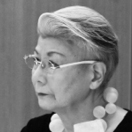
Setsuko Yamada (Japan)
- Design Coordinator,
- Representative of TWIN Inc.
Urushi - a gift from nature. Its extraordinary durability, graceful texture, delicate and variable shade of color, as well as its adaptability of use, are invaluable attributes. I hope that artists will learn from their forebears and add new values and expressions that they can pass on to the next generation.
Many people today are dissatisfied with a society that places priority on simplistic consumption economy. I fear that some Urushi sellers, as well as buyers and users, have lost sight of what authentic Urushi ware is. A tendency to produce cheap items and so-called art-oriented products has spread in the field of lacquer ware. Under these circumstances, the Ishikawa International Urushi Exhibition has been held since 1989. I feel it is my role to assess each submission through an understanding of the aim of the competition.
When making the rounds of the venue to see the works on display, I saw some pieces that impressed me deeply, but not only because of their novelty. I took into consideration the jurors’ individual opinions, as they represent many genres and are highly qualified in making value judgements. All the jurors exchanged their opinions and I am greatly satisfied with the final assessment.
The Grand Prize winner is a lidded food container entitled ‘Life’. The concept and physical attributes of the container are distinctly feminine, and the artist’s technical expression almost allows us to experience the sweet scent of food. I am also very happy with the selection of the two Gold Prize winners. The choice of the Art Category is a platter entitled ‘Weaving Flowers’ with magnificent linear patterns. The winner from the Design Category is a simple bowl entitled ‘Deep Sea’, decorated with the chisel-marks of its creation.
Personally, I was impressed by the small box with a pot-shaped object that boldly tackled the challenge of finding beauty in the capacity for shrinkage in Urushi. I also liked ‘Forbidden Fruit’ with its skilful presentation, as well as many others. I am attracted by works that fit perfectly with our modern lifestyle. I greatly hope that these artists and artisans will never stop working in their endeavors in the field of Urushi.
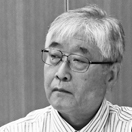
Kaoru Uchino (Japan)
- Urushi Artist,
- Instructor at Ishikawa Wajima Lacquer Arts Training Institute.
I participated in the Final Assessment for the Ishikawa International Urushi Exhibition in 2017 for the first time. This exhibition is not an arts and crafts exhibition but a Urushi exhibition competition, inviting applications from the pubic with only one requirement; works must be lacquered with Urushi. The applicants are able to choose either the Design or Art Category, which encourages the applicants to apply for this exhibition rather easily, I suppose. The purpose of the exhibition is to revitalize the Urushi industry and promote international exchange through proposing new lifestyles as well as new sensitivities by utilizing Urushi.
As a person who has been involved in the transmission of techniques used for important intangible cultural assets, I could sense a freshness in the 80 selected works created with free conceptions and diverse self-expression. The preservation of techniques of traditional arts and crafts has been mainly supported by the spirit of function and beauty from ancient times. I have thought that this fact is quite different from the purpose of this exhibition. However, within the purpose of this exhibition, new sensitivity and new expressions can become new ‘function and beauty’ in the future.
The Grand Prize winner, ‘Life’ by Ms Mayumi Onagi is a lidded food container with a sensitive formation and bold composition. It looks like a solid object at first glance. The lid is gently curved and its inside is colored vermillion. This unexpected contrast makes the work more interesting. The body of the container is made of a Japanese Katsura tree using the kurimono-zukuri technique to form the body, which is then coated using the Suki-Urushi technique. The combined effect of the form of the work and the wood grain makes the viewers feel refreshed. We are touched by her profound sensitivity and the work is worthy of the Grand Prize.
The work entitled ‘Hatouban’ by Mr Yasuo Fujino is made of Japanese cypress with the Kurimono-zukuri technique. It is a rectangular board with powerful wave patterns of the ocean created with his excellent brush work all over the front. The wave patterns look classical but from the crests of the waves we can feel his new sensitivity. What I would like to pay attention to is that he uses a new material - titanium alloy powders. They are treated in the same way as metal powders for Makie. In the case of titanium alloy, the powders consist of various sizes from big to small, which resulted in each wave looking high and distinct. The patterns are created with titanium alloy which is very resilient and so it will not be worn away as easily as gold and silver Makie. So this new material will help revitalize the Urushi industry for the future, I am sure.
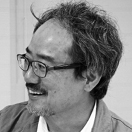
Nobuyuki Tanaka (Japan)
- Urushi Artist,
- Professor at Kanazawa College of Art
The Ishikawa International Urushi Exhibition is the only international exhibition on Urushi in Japan. Since the first exhibition was held in 1989, the exhibition has been held for nearly 30 years. I am sure that this is the result of the enthusiasm for the exhibition of all the parties concerned, including the Executive Committee.
As someone who has worked in Urushi art, I would like to show my most profound esteem for everyone involved in starting this international exhibition with the theme of Urushi toward the new century as well as for continuing the exhibition for a long time.
It has been said many times, but the world of Urushi art faces a harsh reality in the regions where Urushi ware is produced. However, looking at the situation overseas, the field of Urushi art has been rather active. In China, for example, the Hubei International Urushi Triennale has been held at the Hubei Provincial Museum in Wuhan City since 2010 and the International Urushi Biennale started last year in Fuzhou City. They often hold exhibitions focusing on Urushi itself as a natural material as well as focusing on the long history of Urushi art. Quite a few exchange students from colleges, universities and other academic institutions have studied in Japan.
In Western countries as well, solo and group exhibitions of Urushi ware by Japanese artists and artisans have been actively held. In the coming autumn, quite a big exhibition on the expression of Japanese Urushi art will be held at the Minneapolis Museum in the US. It will be at almost exactly the same time when the Ishikawa International Urushi Exhibition 2017 is held.
From an international perspective, the current situation surrounding Urushi has attracted a lot of public attention. Urushi is a material particular to Asian countries. Each country has its own distinctive feature of Urushi art culture. Without a doubt, Urushi art is cultural asset as well as an historical asset. I am sure that the value of Urushi will be increasingly highly evaluated in the future.
Among the submitted works for the Ishikawa International Urushi Exhibition 2017, quite a few are attractive and with forceful expressions. I hope that this exhibition will be enriched and developed as the driving force behind the regional Urushi industry. I also hope that the exhibition will bring excellent works pioneering the future of Urushi in one place, beyond groups or national borders and that the exhibition will help nurture young generations who will be the support and driving force of the future Urushi art world. Thus, the exhibition will surely contribute to promoting world of Urushi art and culture.
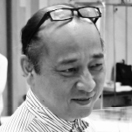
Shinya Yamamura (Japan)
- Urushi Artist
- Professor at Kanazawa College of Art
I participated in the Final Assessment for the Ishikawa International Urushi Exhibition this year for the first time. I carefully considered the difficulty and significance of the assessment.
The exhibition received a variety of excellent works beyond generations and boundaries of the world, which makes this exhibition worthy of its international status. This exhibition is quite different from other exhibitions because the traditional concept of Urushi is developed by cherishing artistic expression and design concepts, as well as other possibilities of Urushi from abroad. The submitted works vary beyond career and time. On the other hand, I feel that we should have reviewed how many works were created through an understanding of the characteristics of the material Urushi and its cultural and historical values. I feel strongly about this particular point even after the Final Assessment.
Creativity of arts and crafts is established through material, technique and expression. When each of the three keeps harmony and balance, arts and crafts can exist as an art of Japan. Naturally, at this exhibition each work is assessed based on the balance of the three conditions. I noticed, however, that many submissions seem to value expression above all else. Artists should recognize the importance of materials and techniques in creating a work of Urushi. Materials and techniques are, to put it another way, nature and human beings. Urushi art can be created and tradition built up only through responding to this magnificent theme. Within the prize winners, I could appreciate the material of the Grand Prize winner, and great technique from the Gold Prize winners. The highly-rated works from overseas considered and interpreted in the same way.
This time, the assessment panel was renewed with many newcomers participating as jurors. A new exhibition of Urushi was to be expected, however, the panel has no jurors from outside Japan and we are curious about reactions from overseas. Assessment is quite difficult because diversity should be considered. Thinking in this way, I would like to show respect to the enthusiasm and efforts of those concerned with the continuation of the competition. I hope that the correct perspective of the times can be confirmed. I also hope that the exhibition will develop and that the only international Urushi exhibition in Japan, will continue to prosper.
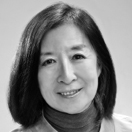
Teruko Mitarai (Japan)
- Representative Director of T-pot Inc.
I was honored to participate in the Preliminary Assessment of the Ishikawa International Urushi Exhibition 2017, as I did for the previous exhibition.
What a variety this year! The submissions vary from fine to industrial arts, design to craft. There are so many different styles of work that it is almost impossible to categorize them into each genre. From all over Japan, Asia, and Europe, artists with their works have come together here at this exhibition.
I would like to draw your attention to a few particularly impressive works.
At the top of the list are ‘Melancholy’ and ‘The Animal Carnival’.
They are part of a series of works submitted by Russian artists.
While the works have a sensitive beauty reminiscent of traditional Japanese Urushi, the scenery is softly drawn with traditional Kashoku technique deeply rooted in Russia.
The scene of Russia looks myterious but charming and it even reminds me of a living creature. Thus, each craft work is inseparably bound up with its producing place.
This is the real thrill of craft.
‘Life Record (Trifoliate Orange)’ is a piece of great taste which manages to evoke the context of the work and the background of the artist. This surely is a true work of art.
The creator of 'Deep Sea' is a wood turner who usually makes wooden containers used in daily life. I think he has been able to refine his artistry to this level of sophistication by aiming for the higher standard of this competition. This piece is evidence of the importance of this exhibition in the wider field of craft.
I look forward to the next opportunity to be part of the jury for this competition, and I hope that works will continue to be submitted from all over Japan and the world.
